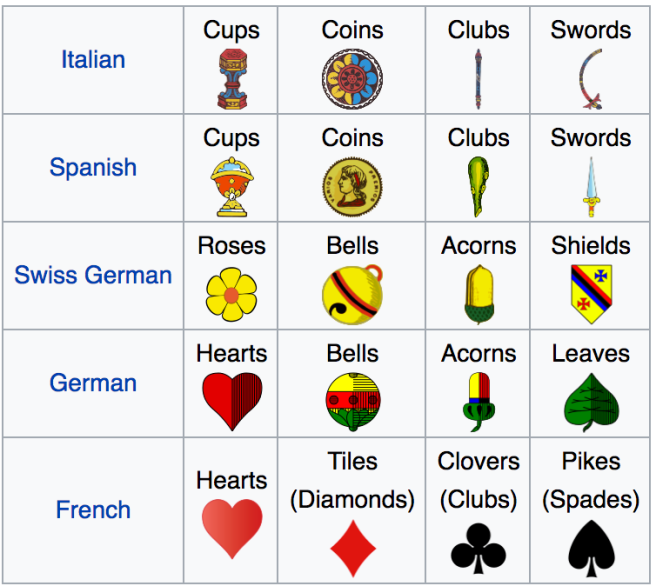For my analysis, I chose to explore playing cards. I considered investigating playing cards in other cultures, cards in person versus online, using cards to gamble versus using them for fun, the cultural connotation of playing cards, or even a comparison of different types of card games. I was most interested in pursuing further research on symbols used for card suits in different countries.


Chinese playing card designs: three of “strings of coins,” three of “coins,” symbol for “myriad of coins,” and symbol for “tens of myriads.”
Spanish playing cards: coins remain coins, myriad become cups, strings become clubs, and tens become swords. Potential values: wealth, treasure, conquest, combat.
Swiss playing cards: coins become roses, cups become bells, clubs become acorns, swords become shields. Potential values: peace, art, music, nature, defense, non-aggression.
German playing cards: roses become hearts, bells remain bells, acorns remain acorns, shields become leaves. Potential values: love, music, nature, peace.
French playing cards: hearts remain hearts, bells become tiles, acorns become clovers, leaves become pikes. Potential values: art, design, mass production, equality.
(American playing cards use French symbols while editing the names to be hearts, diamonds, clubs, and spades. The names “clubs” and “spades” relate back to the Spanish/Italian suits. Potential value(s): cultural melting pot.)

My hypothesis for this proposed research was, “There is an observable correlation between the cultural values of a country and the symbols used in their playing card suits.”
My proposed testing method goes as follows:
- Conduct an in-depth analysis of relevant art and literature from the same country and the same time period as the selected playing card set.
- Make note of the frequency and context in which symbols from the cards appear in other forms.
- Read relevant studies published about the cultural values from that country and time.
- Observe whether or not the symbols are used to by the culture to represent their values.
Sources:
Johnson, J. (2011, November 7). Design History: The Art of Playing Cards. Retrieved April
29, 2017, from https://designshack.net/articles/layouts/design-history-the-art-of-
playing-cards/
McLeod, J. (n.d.). . Games classified by type of cards or tiles used. Retrieved April 29,
2017, from https://www.pagat.com/class/#equipment
McLuhan, M. (1964). The Medium is the Message. In Understanding Media: The Extensions
of Man (pp. 1-18). New York City, New York: McGraw Hill.
Suit (cards). (n.d.). Retrieved April 29, 2017, from
https://en.wikipedia.org/wiki/Suit_(cards)
Wintle, S. (2016, December 1). Angler Skat. Retrieved April 29, 2017, from
http://www.wopc.co.uk/germany/ass/angler-skat















